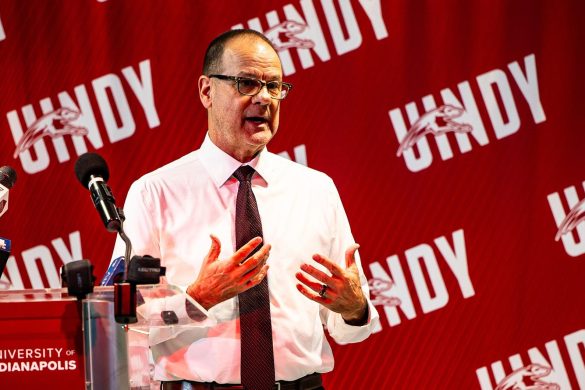 The Tax Cuts and Jobs Act was signed into law on Dec. 22, 2017. Under the new tax plan, both corporate and individual tax rates are being cut. Corporations and individuals, however, are not the only ones who will be impacted, higher education will be as well, according to University President Robert Manuel.
The Tax Cuts and Jobs Act was signed into law on Dec. 22, 2017. Under the new tax plan, both corporate and individual tax rates are being cut. Corporations and individuals, however, are not the only ones who will be impacted, higher education will be as well, according to University President Robert Manuel.
The tax plan essentially doubles standard deductions for taxpayers to $24,000 for joint-filers, and $12,000 for single filers. The increase in standard deductions also applies to charitable donations made by taxpayers, meaning they would have to donate more they would previously to reap the tax benefits that come with them. According to President and CEO of the Independent Colleges of Indiana David Wantz, the incentive for making charitable donations to universities could be diminished by the increased rate of standard deductions.
“Small donors become large donors over time,” Wantz said. “If there is no incentive to give the small gift, it makes it harder to encourage people to give a larger gift. Giving is all about relationships, and so colleges and universities… want to start the habit of giving early to continue to grow and encourage that habit.”
Between June 30, 2016 and June 30, 2017 5,852 donations were made to UIndy, totaling $11,978,151; and of those donations, 75 percent were gifts of $250 or less, said Vice President for University Advancement Christopher Molloy.
According to Wantz, the reduction in individual tax rates also could mean that some people may be more willing to donate because they have extra money left over that previously would have been taxed.
“The contrary argument to this is, ‘Wait a minute. If people have more money in their pocket at the end of the day, they may be more inclined to give,’” Wantz said. “We don’t know that…. I’m not as hopeful about that one. But I think in Indiana, in particular, there is an additional problem. At the statehouse, there’s an amendment to a bill to repeal the state tax credit for giving to colleges and universities.”
Whereas deductions are based on the adjusted gross income of an individual or joint-filers, tax credits give donors a specific amount of money that they can reduce from the amount of state taxes that they owe, based on how much they donated. According to Wantz, if the bill passes it could mean a double-whammy for universities in Indiana, because of the reduction in donation deductions and the elimination of the state tax credit for donating.
Along with the possible impact the tax plan will have on donations to the university, it will have an effect on UIndy’s direct placement bonds, according to Manuel. Direct placement bonds are generally loaned out by a bank for an institution, such as a university, to invest, according to financial-dictionary.thefreedictionary.com.
If any university sets up a direct placement bond, it must adhere to the contract established between the university and the bank. According to Manuel, one of the terms of UIndy’s direct placement bond contract is that if the corporate interest rate changes in any way—either an increase of decrease—then the interest rate of the university’s bond would increase. In the case of the new tax plan, the corporate interest rate has decreased, but the change still triggers an increase in the university’s interest rates for the borrowed money, Manuel said.
“The bank is in a better position financially because the interest rates have gone down, and they are just making more money because of that contract issue,” Manuel said. “We go to the bank and say, ‘Wouldn’t it be nice if you gave us a gift equivalent to the amount of money that you are making, because for no reason of your own, you’re just making more money.’ So that conversation is happening now. And the other thing we do is we look to see what kind of impact that is and whether or not you can refinance it [the direct placement bond].”
Manuel said the rise in the bonds’ interest rates will not create significant financial stress, and that refinancing the bonds may be possible, which would allow for new terms to be place on the contract.
Some of UIndy’s bonds, however, are publicly placed and will not be impacted by the new tax plan, according to Manuel. Publicly placed bonds, which generally help fund construction of new facilities, renovation of existing facilities, purchase of real property, the purchase of equipment, etc., are tax-exempt and therefore are unaffected by the changes that increase the direct placement bonds according to higheredcompliance.org.
The new endowment tax that has been included in the tax plan will impose a 1.4 percent excise tax on investment income at private colleges with an enrollment of at least 500 students valued at $500,00 per full-time student, according to insidehighered.com. Although the change does not directly impact UIndy, according to Wantz, the tax feeds into a larger issue of distrust against higher education institutions.
“This is part of the national dialogue, that colleges and universities are sitting on these huge bank accounts—they are constantly growing these investments—and yet that money is not reducing the cost of attendance,” Wantz said. “It couldn’t be further from the truth. At one point, seven of our colleges in Indiana were targeted, and the colleges in Indiana use that money to fund a lot of things, including student scholarships.… If I give you money, and I say, ‘I want you to use this money to fund student scholarships,’ you can’t use it for any other purpose than the one I gave it to you for. So it [university endowment] is not a big savings account; it’s money held in trust.”
Although the tax plan will have some impact, whether large or small, on UIndy’s finance the price of tuition for students will not be affected by the changes, according to Manuel.
“The wrong response to this [the new tax plan] would be to send your tuition high, because then nobody would be able to access the education. The right response is to figure out how to appropriately price and find support to continue the work we’re doing. The good news about UIndy is the uniqueness of the academic experience is high, and we’ve just started now to kind of communicate that out. You can tell by the number of people that are interested in coming here. Schools that don’t have that unique program or curriculum or experience are the ones that are floundering a little bit. So we have this really unique program—people want to be here—and now our job is to figure out how to engage them differently. It’s a much sweeter problem to have than some of our colleagues around the country.”
According to Manuel, the changes made by the tax plan also could be beneficial to universities because of the possibility of corporate philanthropy and reduced tax rates on employees.
“It’s hard to say because individuals will feel relief. They’re going to get a little more of their paychecks, and that is wonderful. They will feel that, and that’s a benefit,” Manuel said. “Hopefully, the reduction in the corporate tax rate will increase corporation and foundation philanthropies—that they give—which would also have a positive benefit. But the constant attack on institutions as financially inefficient organizations continues to erode the confidence in higher education in general, which has horrible long-term effects on society’s ability to compete, be competitive and create quality-of-life experiences that everybody wants. Until we get to a point where higher education is at the table having conversations about these things and recognized as the partner it is to producing inquisitive, insightful, collaborative, collegial, creative people in the world, we’re going to end up with missed opportunities.”
Although some of the aspects of the Tax Cuts and Jobs Act may negatively impact universities, many of the original provisions that worried Manuel, Wantz and Molloy were removed from the bill before it was passed.
One of these original provisions would have imposed a tax on the tuition remission that UIndy employees—from faculty members to those working in the physical plant—receive for their children or dependents, according to Wantz. Another provision would have taxed graduate assistants’ tuition and stipends that they receive, which, according to Molly, would have dissuaded some from seeking a graduate degree.
“That’s the way policy is working lately,” Manuel said. “It used to be that it was kind of thought out and negotiated and brought forward, and then it was moderated. It seems to be coming out from wherever first, without the benefit of true thought….You’ve got to be much more vigilant about what you’re looking at, because if you’re not careful, these things squeak through, and then your finances are in jeopardy.”
According to Manuel, the Tax Cuts and Jobs Act is often seen in black and white, without any grey area. He said, however, that the tax plan involves both positive and negative aspects that must be taken into account.
“Balance the organizational impact against the individual impact…. Because so much of what we are anymore is either/or. There’s no ‘and’ anymore. And the ‘and’ is poignant here,” Manuel said. “There are individuals that will be benefited from this tax plan, and that is incredible. It’s a wonderful thing. And they will be benefited short-term differently than long-term. But the organization is a different entity. So no individual is going to be impacted by that. . . . The fact is, it’s good and bad. It’s not good or bad. It’s both. And it just means you’ve got to change some of your operations as you go. That nuance is lost in every story that’s ever been written about this tax plan. It’s always taken from one vantage point, one little view, and it’s either good or bad. I can see benefits in both.”








